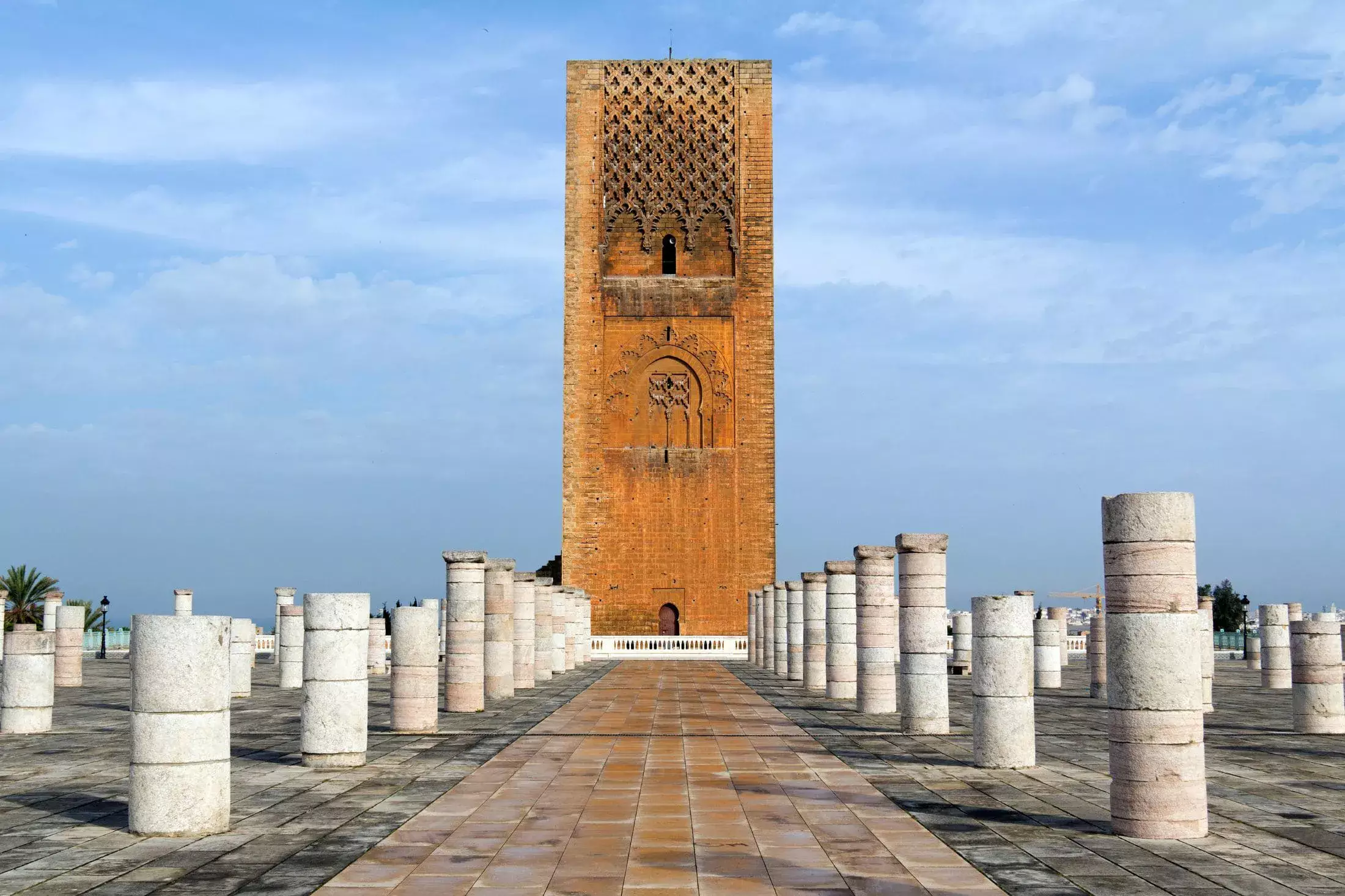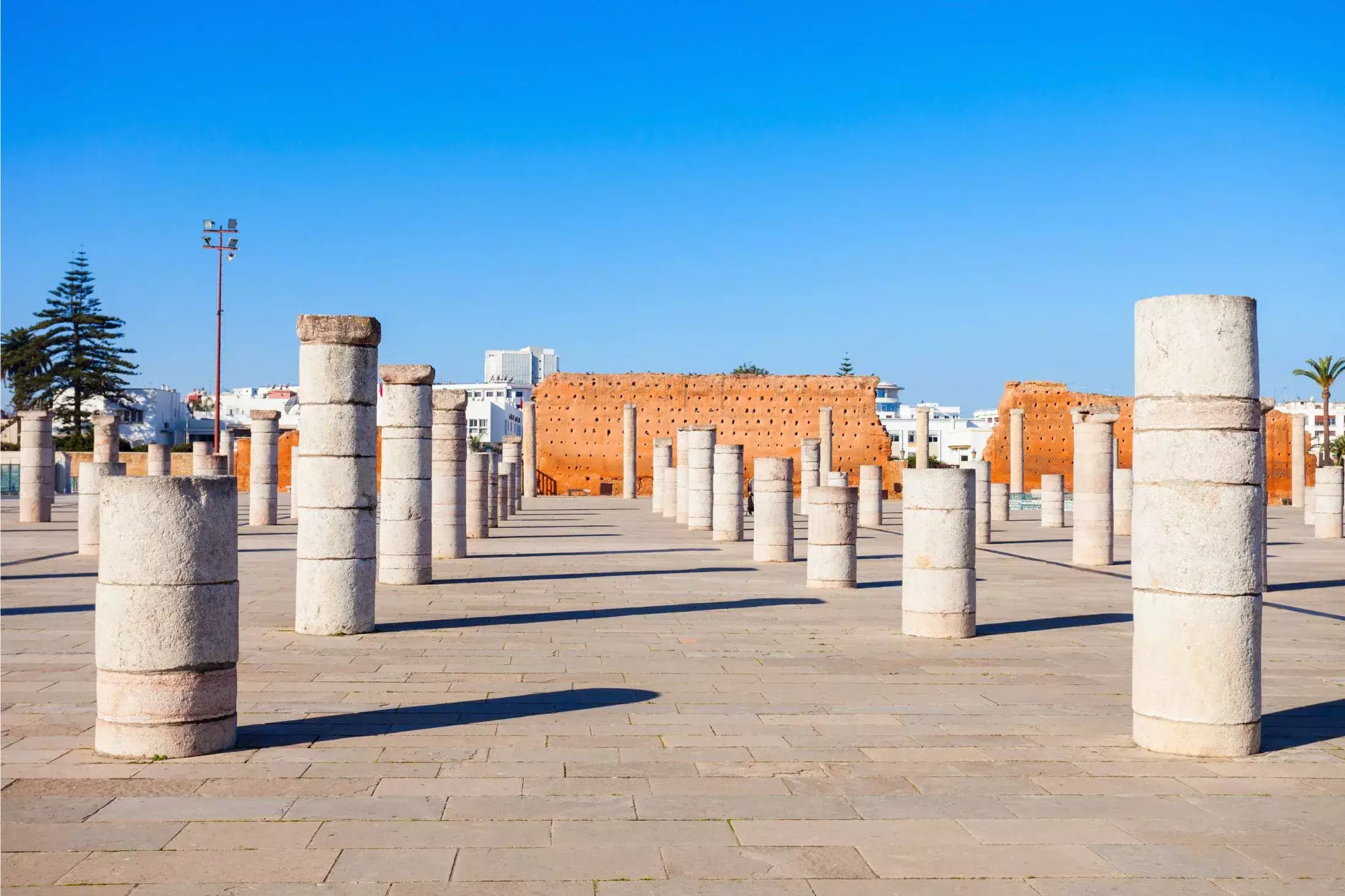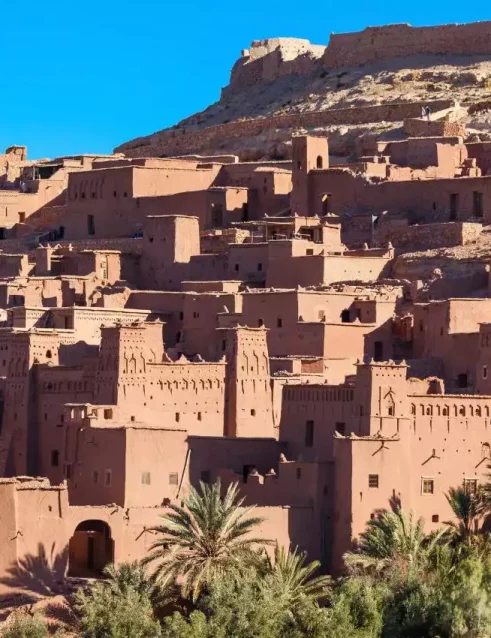Hassan Tower

Hassan Tower: Unveiling the Splendor of Rabat's Iconic Landmark
Despite its incomplete status, the tower has survived through time, embodying Moorish and Islamic architectural elements that capture the eye of visitors and scholars alike. With each of its detailed facets telling a piece of Moroccan history, the Hassan Tower has been excavated and restored to ensure that it remains preserved for future generations to appreciate. Its robust presence is further amplified by its positioning overlooking the Atlantic Ocean, further cementing its place as an iconic feature of Rabat’s skyline.
Recognizing its historical value and the craftsmanship it represents, the Hassan Tower has been included as part of the Rabat, Modern Capital and Historic City: a Shared Heritage, which is a UNESCO World Heritage site. This acknowledgment underscores the tower’s importance, not just as a physical structure but also as a cultural treasure that continues to draw interest from around the globe. Visitors to Hassan Tower Morocco can immerse themselves in the grandeur of medieval Islamic architecture and gain insight into the rich history that shapes much of Morocco’s heritage

History
Hassan Tower in Rabat, Morocco, stands as an emblem of the Almohad dynasty’s architectural ambition. It reflects a cultural heritage pillar and a formidable attempt to create a landmark religious edifice
Construction
Initiated by the Almohad Caliph Abu Yusuf Yaqub al-Mansur towards the end of the 12th century, the construction of the Hassan Tower was a project of grand scale, aimed at demonstrating the might and sophistication of the Almohad Caliphate. The objective was to erect not just the tallest minaret but also to encompass what would have been the world’s largest mosque. Building efforts started around 1195 but were eventually left incomplete due to the Caliph’s death in 1199.
Destruction and Preservation
While never completed, Hassan Tower has withstood the test of time enduring destruction and preservation efforts through the centuries. An earthquake in 1755 caused severe damage to the structure, collapsing much of the mosque, leaving the tower standing amidst the ruins. Notwithstanding, the truncated tower, soaring to approximately 44 meters (140 feet), has been preserved and remains a significant historical site. It was further recognized for its historical value when it was listed as a UNESCO World Heritage Site in 1995, symbolizing the timeless grandeur of Morocco’s Islamic history
Architecture
Hassan Tower in Morocco is a testament to the architectural prowess of the Almohad era, exhibiting both the grandeur of its envisioned scale and the intricacies of Moorish and Islamic designs
Design Elements
The design of Hassan Tower integrates robust geometric structures and ornamental features typical of Almohad architecture. It stands on a square base, which is quite characteristic of Moroccan minarets. The tower’s silhouette is marked by distinct corner shafts, which would have supported the height it was meant to achieve. The façade is embellished with intricate patterns, including ornamental arches and columns that showcase the precision of Almohad craftsmanship.
Visitors today can observe the horseshoe arches, a defining attribute of Almohad style. These arches not only fulfill an aesthetic function but also demonstrate engineering acumen. The red sandstone used in construction gives the minaret a distinct color, which contributed to the visual impact it would have made within the cityscape. The incomplete structure of Hassan Tower stands at approximately half of its intended height of 88 meters, yet its elegance and attention to detail remain evident and admired.
Symbolism
Hassan Tower holds significant symbolic weight as a cultural and historical icon. Although the mosque associated with the tower was never completed due to the death of Sultan Yacoub El Mansour, the structure’s existence speaks to the grand ambitions of the Almohad Caliphate. It was conceived to be the largest minaret in the world and a symbol of Islam’s reach and influence during the 12th century in the western Islamic world.
The minaret’s intended scale and prominence reflect the Almohad Dynasty’s aspiration to showcase Rabat as a powerful, spiritual, and administrative capital. Even unfinished, Hassan Tower stands as a powerful emblem of Morocco’s storied past and its enduring architectural heritage
Symbolism

Cultural Significance
Hassan Tower in Rabat is not just an architectural marvel but also a profound cultural emblem for Morocco. It encapsulates the nation’s rich history and stands as a symbol of both religious convictions and national pride.
Religious Importance
Hassan Tower is a celebrated religious landmark due to its original purpose as the minaret of an incomplete mosque. Commissioned by the Almohad ruler, Abu Yusuf Yaqub al-Mansur, the tower was earmarked to be the largest minaret in the world. Although the mosque remains unfinished, the minaret’s presence emphasizes Morocco’s significant Islamic heritage.
National Monument Status
Declared a national monument, Hassan Tower’s role extends beyond religion. It has indeed become an integral part of the Moroccan identity, representing a historical era that shaped the civilization. The site also works in conjunction with the Mausoleum of Mohammed V, honoring Morocco’s past monarchs and strengthening national sentiment.

Tourism
Preserving the Hassan Tower is critical due to its historical significance and architectural grandeur. Various measures have been taken to ensure its stability and longevity
Conservation Efforts
Hassan Tower in Rabat is a significant attraction for travelers interested in the historical and architectural grandeur of Morocco. Tourism at this site offers comprehensive insights into the country’s heritage through organized visits and dedicated facilities.
At the Hassan Tower Visitors Center, individuals can access essential information about the monument and available activities. A range of informative displays provides background on the tower’s history and cultural context. The center is designed to assist tourists in maximizing their experience at this iconic landmark. For convenience, amenities such as restrooms and a gift shop are available.
Renovation Projects
In an effort to protect the tower from collapse, renovations have been periodically conducted, with intensive repairs carried out in 1946 during the French Mandate. Despite these efforts, the tower still requires restoration to maintain its condition and prevent deterioration.
International Cooperation
To facilitate better monitoring and understanding of its preservation state, there has been global collaboration. Techniques and strategies from around the world contribute to the conservation efforts, ensuring that the Hassan Tower is not only restored but also maintained for future generations. International expertise and resources play a key role in these ongoing conservation activities.
Location and Accessibility
Hassan Tower, an emblematic minaret situated in Rabat, Morocco, is not only a key historical site but also highly accessible to visitors. Its central location is well-connected and within close proximity to various points of interest, ensuring a convenient visit.

Transport Links
Rabat’s transportation network makes reaching Hassan Tower straightforward. Visitors can utilize the city’s tram system, with its nearest stop only a short walk from the tower. For those arriving by train, Rabat Ville Train Station is the main hub, and from there, one can catch a taxi or a bus to the site. For international or domestic travelers, Rabat-Salé Airport serves as the closest airport, and taxis are readily available to shuttle tourists directly to the vicinity of Hassan Tower.
Nearby Attractions
Adjacent to Hassan Tower, one will find the remnants of what was to be the mosque’s grand esplanade, enhancing the site’s historical context. Just a stone’s throw away, the Mausoleum of Mohammed V
offers its visitors a look into Moroccan royal history, majestically gracing the Rabat skyline. Additionally, the ancient ruins of Chellah, a testament to the city’s Roman and Islamic heritage, are only a 10-minute drive. The Kasbah of the Udayas, accessible within a 5-minute drive, provides panoramic views and a glimpse into the city’s defenses of yesteryears
Events and Ceremonies
Hassan Tower in Rabat is not only an architectural wonder but also a pivotal site for a variety of events and ceremonies that embody the historical and cultural ethos of Morocco. Each year, Hassan Tower becomes the focal point for numerous Moroccan annual celebrations that are deeply rooted in Moroccan tradition. These events often attract a large number of tourists and locals alike, who gather to partake in the festivities. Mawlid al-Nabi, the birthday of the Prophet Muhammad, is among the notable religious occasions marked by special prayers and recitations at the site of the Tower.
The site of Hassan Tower also hosts special occasions which include official ceremonies and cultural gatherings. Royal events, for example, have been known to take place here, commemorating significant moments in Morocco’s history. The architectural splendor of the tower and its surroundings provide a dignified backdrop that enhances the solemnity and significance of these events.
Educational Value
Visitors to Hassan Tower gain invaluable insights into the Almohad dynasty’s architectural technique and cultural imprints. The site demonstrates remarkable craftsmanship, where the red sandstone’s intricate carvings become a visual textbook of historical Moroccan artistry. Tours often highlight geometric patterns and decorative motifs that are distinctive to this period, providing an immersive learning experience that connects them to the 12th century.
Observation Points
The 44 meters height of Hassan Tower grants panoramic views of Rabat’s landscape, allowing for a literal overview of the city’s evolution from historical times to modern days. At various points, one can admire the comprehensive layout of what was once intended to be the world’s largest mosque. Although the project remained unfinished, the towering minaret still offers strategic vantage points for observers to contemplate the fusion of ancient achievements with the surrounding city’s natural and urban environment.

Challenges
The Hassan Tower faces a range of issues including the preservation of its ancient structure and the integration of modern development in its vicinity.
The Hassan Tower’s longevity is threatened by environmental factors and the natural wear and tear expected with aging monuments. Efforts to preserve it require meticulous attention to the original materials and construction methods. Climate conditions, such as the saline air from the Atlantic, contribute to the erosion of the stone, requiring ongoing maintenance.
The impact of modern infrastructure on the historic fabric of the Hassan Tower’s site is a concern. There is a delicate balance between developing Rabat as a modern city and preserving the Tower’s surroundings. Urban development presents challenges including vibration damage from traffic and potential visual intrusion from new construction.
Frequently Asked Questions
The Hassan Tower remains a gem of Moorish architecture and historical significance, capturing the imagination of visitors and historians alike. This section seeks to answer some of the most common queries about this iconic landmark.
Why is the Hassan Tower important?
The Hassan Tower is a symbol of Morocco’s imperial history and is renowned for its architectural grandeur. It serves as a testament to the Almohad dynasty’s ambition and the Islamic heritage of Morocco.
How tall is Hassan Tower?
The Hassan Tower stands at 44 meters (140 feet), although it was initially intended to reach approximately 260 feet, which would have made it the largest minaret in the world.
Who built the Hassan Tower and when?
Currently, visitors cannot access the interior of the Hassan Tower. However, they are able to explore the surrounding site, which includes the remains of the incomplete mosque.
Can visitors access the interior of Hassan Tower?
Sultan Yacoub El Mansour of the Almohad Dynasty commissioned the tower’s construction, with work beginning around 1195 AD but left unfinished at the time of his death.
What architectural style is Hassan Tower known for?
Hassan Tower was intended to be the minaret for what would have been the world’s largest mosque, reflecting the grand vision of the Almohad ruler who commissioned it.
What was the intended purpose of Hassan Tower before construction halted?
The tower is a distinguished example of the Moorish architectural style, characterized by intricate geometric patterns and robust construction
How can one obtain tickets to visit the Hassan Tower complex?
Tickets to visit the Hassan Tower complex are typically available at the entrance of the site, and the complex is often included as part of guided tours in Rabat.
As we reflect on the rich tapestry of history and culture that Hassan Tower weaves into the heart of Rabat, it’s evident that this monumental structure is much more than an unfinished project of the past; it stands as a vibrant beacon of Moroccan heritage and architectural brilliance. Whether it’s through the intricate carvings that adorn its façade, the strategic significance of its location, or the symbolic weight it holds, Hassan Tower continues to captivate and educate its visitors.
Its inclusion as a UNESCO World Heritage site not only honors its historical and cultural importance but also ensures that future generations will continue to learn from and appreciate this iconic minaret. As Hassan Tower stands resilient against the backdrop of Rabat’s evolving skyline, it remains a profound testament to Morocco’s rich history and its enduring spirit. For those drawn to the allure of historical sites, the Hassan Tower offers an unmissable journey into the heart of Morocco’s architectural and cultural legacy.









